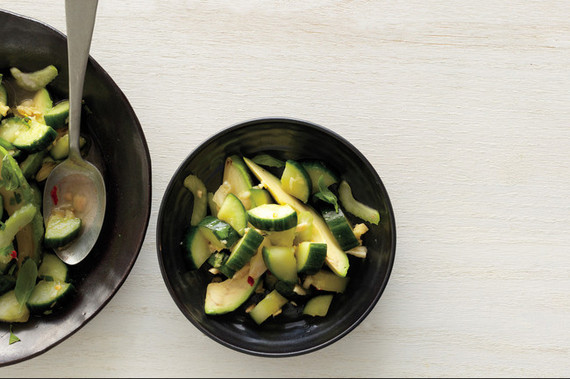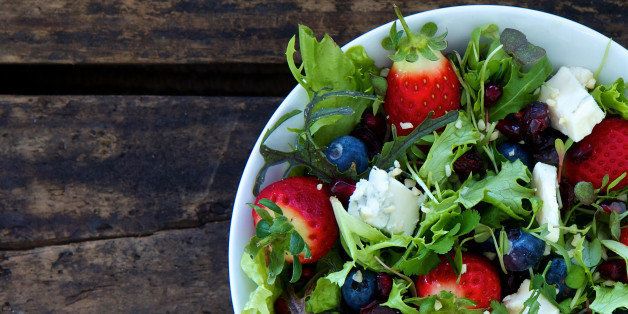By Anna Stockwell, Epicurious
To really understand my four-step process when building a great salad, I have to first explain how my brain works in relation to food. I crave food not just by flavor but by texture and temperature. In creating a new recipe or a meal, I imagine how I want each bite to feel in my mouth. I've always been this way--my mom would ask "what should we make for dinner?" and I'd answer with descriptions of how I wanted things to feel: "I want something I can really chew on.""Something soft." "Something crunchy."
So it's no surprise that I'm a sucker for salads, where chewy, soft and crunchy easily coexist. But that brings me to my second craving: temperature. Unless it's the hot height of summer, I don't really like to eat an exclusively cold dinner. So I make sure my salads have a mix of cold and warm parts.
The resulting salad might be kale with warm cubes of sweet potato, warm quinoa, cold slivered apples and creamy goat cheese. Or maybe spinach with hot roasted cauliflower florets, creamy avocado slices, and some extra crunchy pumpkin seeds, all topped with a fried egg. Or thinly sliced lacinato kale tossed with cold brown rice, crunchy cold cucumbers, creamy feta, lots of fresh herbs and some hot grilled steak.

JOHNNY MILLER
Of course, it all depends on what I have on hand at the time. But as long I stick to the rough plan below, I end up with a salad that satisfies on every level.
STEP 1: START WITH HEARTY GREENS
Since my salads have both cold and hot/warm elements, they should start with raw greens like spinach or kale--greens that benefit (rather than suffer) from a little bit of wilting.
STEP 2: ADD SOMETHING COLD
Cold and Crunchy
Thinly sliced or shaved raw fennel, carrots, radishes, beets, cucumbers, bell peppers, or zucchini. Sliced apples or pears are always great here too, as are bean sprouts.
Cold and Creamy
Any kind of cheese always makes salad better. Ditto avocado. Cold hard boiled eggs and cold cooked beans fit in this category too.
Cold and Chewy
Cold leftover meats, salami, olives, or any dried fruit are nice cold, chewy additions. Leftover cooked grains used cold work too.

ROMULO YANES
STEP 3: ADD SOMETHING WARM
Warm and Crispy-edged
Try any roasted vegetables that are caramelized and crisp on the outside and tender inside, like sweet potatoes, cauliflower, mushrooms, carrots, or any kind of squash.
Warm and Creamy
Eggs: soft boiled, fried, or over-easy--so long as they have a runny yolk that turns into a creamy warm dressing over your salad. Cooked beans warmed in a little olive oil also satisfy the warm and creamy itch.
Warm and Chewy
Steamed beets, asparagus, green beans, or broccoli; reheated leftover chicken, pan-seared and sliced steak, duck, or pork tenderloin are all good additions. Warm cooked brown rice, quinoa, or other whole grains fit in this category too.
STEP 4: DRESS TO TASTE, FINISH WITH CRUNCH
The dressing is where you get to really play with flavor: make your own and the sky's the limit on what kind of ingredients you can use. The dressing is also another place you can add texture: a creamy yogurt dressing can be amazing on an otherwise crunch-forward salad. Once it's dressed, add even more crunch (the dressing will help the crunchy bits stick to everything else). Nuts and seeds are never out of place in any salad. Neither are croutons. But the adventurous salad maker may want to go even further.
Our 2024 Coverage Needs You
It's Another Trump-Biden Showdown — And We Need Your Help
The Future Of Democracy Is At Stake
Our 2024 Coverage Needs You
Your Loyalty Means The World To Us
As Americans head to the polls in 2024, the very future of our country is at stake. At HuffPost, we believe that a free press is critical to creating well-informed voters. That's why our journalism is free for everyone, even though other newsrooms retreat behind expensive paywalls.
Our journalists will continue to cover the twists and turns during this historic presidential election. With your help, we'll bring you hard-hitting investigations, well-researched analysis and timely takes you can't find elsewhere. Reporting in this current political climate is a responsibility we do not take lightly, and we thank you for your support.
Contribute as little as $2 to keep our news free for all.
Can't afford to donate? Support HuffPost by creating a free account and log in while you read.
The 2024 election is heating up, and women's rights, health care, voting rights, and the very future of democracy are all at stake. Donald Trump will face Joe Biden in the most consequential vote of our time. And HuffPost will be there, covering every twist and turn. America's future hangs in the balance. Would you consider contributing to support our journalism and keep it free for all during this critical season?
HuffPost believes news should be accessible to everyone, regardless of their ability to pay for it. We rely on readers like you to help fund our work. Any contribution you can make — even as little as $2 — goes directly toward supporting the impactful journalism that we will continue to produce this year. Thank you for being part of our story.
Can't afford to donate? Support HuffPost by creating a free account and log in while you read.
It's official: Donald Trump will face Joe Biden this fall in the presidential election. As we face the most consequential presidential election of our time, HuffPost is committed to bringing you up-to-date, accurate news about the 2024 race. While other outlets have retreated behind paywalls, you can trust our news will stay free.
But we can't do it without your help. Reader funding is one of the key ways we support our newsroom. Would you consider making a donation to help fund our news during this critical time? Your contributions are vital to supporting a free press.
Contribute as little as $2 to keep our journalism free and accessible to all.
Can't afford to donate? Support HuffPost by creating a free account and log in while you read.
As Americans head to the polls in 2024, the very future of our country is at stake. At HuffPost, we believe that a free press is critical to creating well-informed voters. That's why our journalism is free for everyone, even though other newsrooms retreat behind expensive paywalls.
Our journalists will continue to cover the twists and turns during this historic presidential election. With your help, we'll bring you hard-hitting investigations, well-researched analysis and timely takes you can't find elsewhere. Reporting in this current political climate is a responsibility we do not take lightly, and we thank you for your support.
Contribute as little as $2 to keep our news free for all.
Can't afford to donate? Support HuffPost by creating a free account and log in while you read.
Dear HuffPost Reader
Thank you for your past contribution to HuffPost. We are sincerely grateful for readers like you who help us ensure that we can keep our journalism free for everyone.
The stakes are high this year, and our 2024 coverage could use continued support. Would you consider becoming a regular HuffPost contributor?
Dear HuffPost Reader
Thank you for your past contribution to HuffPost. We are sincerely grateful for readers like you who help us ensure that we can keep our journalism free for everyone.
The stakes are high this year, and our 2024 coverage could use continued support. If circumstances have changed since you last contributed, we hope you'll consider contributing to HuffPost once more.
Already contributed? Log in to hide these messages.


